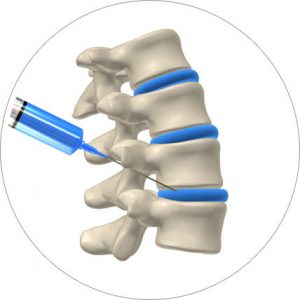Non-Operative Spine Injection
A spinal injection is given to help reduce pain and improve the function of the spine. The injection helps relieve pain by reducing inflammation. The type of injection you receive is dependent upon your symptoms and physical examination.

A spinal injection is performed under X-ray guidance, a technique called fluoroscopy. This technique ensures correct placement of the injection and improves safety.
First, a liquid contrast, or a dye, is injected before the medication. If the dye does not flow into the correct location, then the needle is repositioned and more dye is injected until the correct flow is obtained. Once the correct flow pattern is achieved, then the medication is injected.
Epidural Injections
These injections are therapeutic and involve injecting an anesthetic and anti-inflammatory medication near the affected nerve. This helps to resolve pain and reduce inflammation. The injection can be done at a very specific, isolated nerve to determine which nerve is the source of pain.
Facet Joint Injections
This injection is both therapeutic and diagnostic. It is often used when pain is caused by degenerative arthritic conditions or injury. It is typically used to treat neck, middle back, and lower back pain.
Facet Joint Injections can be injected in two different ways. First, an anesthetic can be injected directly into the joint or nerves carrying the pain signals away from the joint. If most of the pain is relieved with anesthetic into the joint, then a therapeutic injection of a steroid is given to provide lasting pain relief.
Sacroiliac Joint Injections
This injection is similar to facet joint injections. Sacroiliac joints are located between the sacrum and ileum, known as the pelvic bones. Problems with the sacroiliac joints are known to cause pain in the lower back, buttock, and leg. Generally, one joint is painful and causes pain on one side of the lower body.
A sacroiliac injection is performed under X-ray guidance.
Provocation Discography
This is a type of spinal injection that is done only for the diagnosis of pain. There is no pain-relieving effect. It is designed to reproduce a person’s pain in order to find the source of longstanding back pain that fails to diminish with comprehensive, conservative treatment.
Discography is performed by stimulating and pressurizing a vertebral disc. This is done by injecting a liquid into the center of more than one disc to distinguish a problem disc from another.